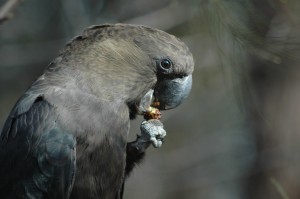Ever wanted to do your bit to contribute to the environment and threatened species research? Citizen science allows you to do just that.
This coming Sunday, October 30, marks the seventh year of the Glossy Black-Cockatoo Birding Day, an initiative of the Glossy Black Conservancy.
Griffith researchers say the initiative will help them better understand the distribution patterns, habitat use and population performance of the Glossy Black-Cockatoo.
Griffith School of Environment’s Dr Guy Castley said the Glossy Black-Cockatoo, or scientifically known as Calyptorhynchus lathami lathami, is distributed throughout south-eastern Queensland and New South Wales and is listed as vulnerable in both states.
 The Glossy Black-Cockatoo Birding Day documents sightings of the species across SEQ and north-eastern NSW from dawn to dusk to provide a snapshot of the distribution but also provide insights into the population structure.
The Glossy Black-Cockatoo Birding Day documents sightings of the species across SEQ and north-eastern NSW from dawn to dusk to provide a snapshot of the distribution but also provide insights into the population structure.
“With the assistance of volunteers, this Birding Day will enable us to build a picture over time of the numbers, distribution and social structure of these birds,” Dr Castley said.
“By combining these data with sightings reported at other times, through the Conservancy’s online reporting tool, we are better informed to develop effective conservation guidelines for the species.”
Gold Coast residents will be out and about from Pimpama to Currumbin, and from the coast to the hinterland in search of these somewhat elusive birds.
Any records from the Gold Coast are then combined with those from other regions to provide a snapshot of where these cockatoo were seen on the day.
Last year nearly 200 volunteers spent the day searching for the Glossy Black-Cockatoo in ten regional council areas but only recorded 60 birds. While numbers in 2015 were the lowest since the surveys commenced in 2010 there is considerable variability in the annual counts.
Members of the public who have not yet signed up and are interested in participating on the day should contact the regional coordinator of the event in their area to get further information. Regional coordinator details can be obtained via the Glossy Black Conservancy website.
Dr Castley said the Glossy Black-Cockatoo species was cryptic in its behaviour and use of natural habitats but also has quite specific habitat requirements.
“It is a fussy eater, feeding only on the cones of certain species of she-oak trees. It also needs tree hollows for nesting and visiting watering holes to drink each afternoon.”
